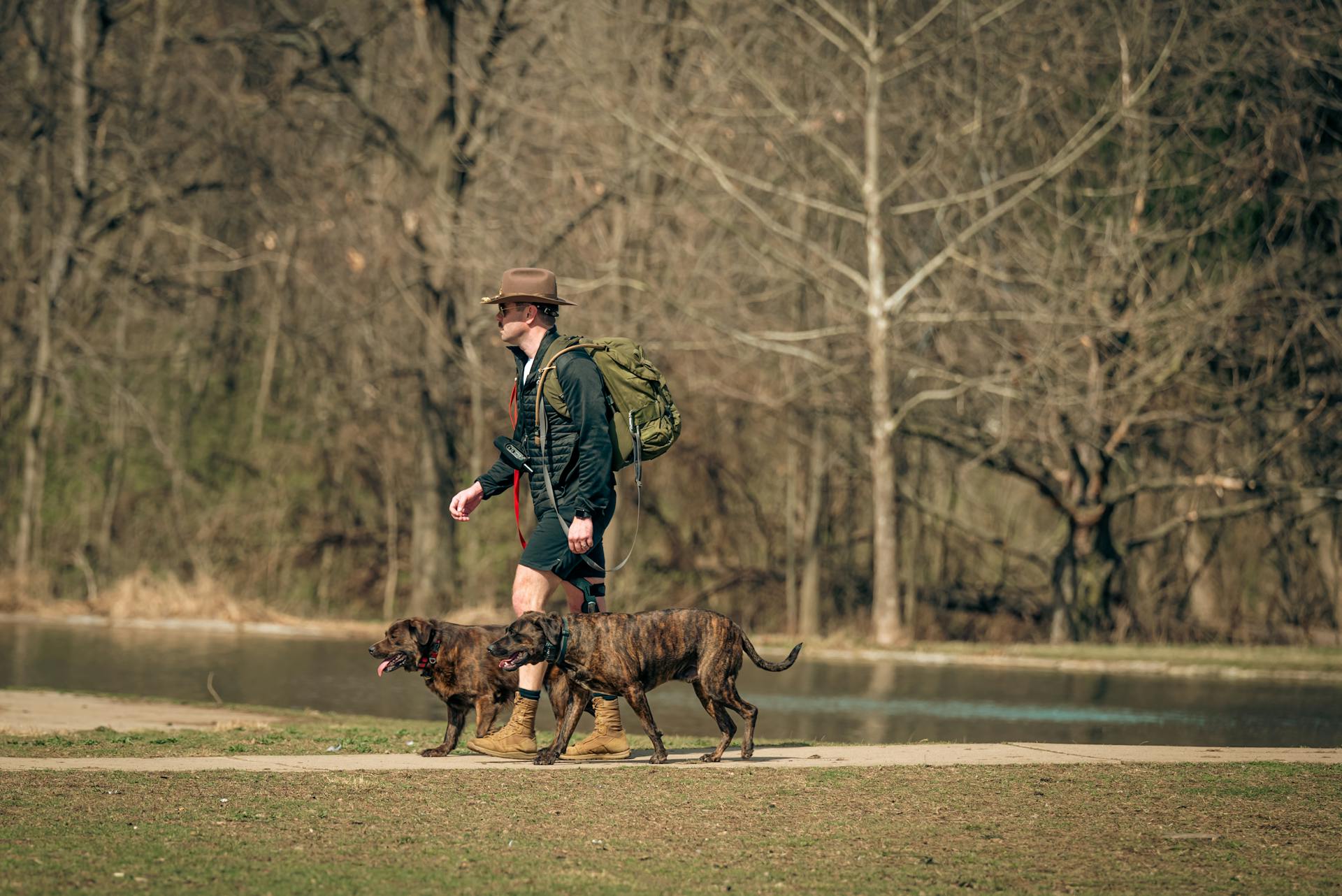
Limber Tail Syndrome, also known as Acute Tail Trauma, can cause a dog's tail to become stiff and unresponsive.
This condition is usually caused by muscle strain or injury, which can be triggered by overexertion, injury, or even just a sudden movement.
Symptoms of Limber Tail Syndrome include a tail that's held low or to the side, and a lack of wagging or movement.
A dog's tail is a vital part of its communication, and a lack of wagging can be a sign of underlying pain or discomfort.
Take a look at this: Tail Wagging by Dogs News
Causes and Symptoms
Dogs that suffer from limber tail syndrome often have a history of unaccustomed exercise, particularly if they're working dogs returning to work after a break.
Prolonged confinement, such as being crated for a long journey, can also contribute to the development of limber tail.
Exposure to cold, wet conditions, especially in water that's too cold, can cause a temporary lack of blood flow to the tail region, leading to muscle injury and pain.
Dogs that are prone to limber tail often exhibit symptoms such as a limp, hanging tail, and sensitivity to touch at the site of injury.
Other signs may include frequently shifting positions, trouble rising or walking, hesitation or difficulty defecating, and reduced or absent appetite.
The following factors are commonly associated with limber tail:
- Unaccustomed exercise
- Prolonged confinement
- Exposure to cold, wet conditions
It's essential to note that these symptoms can also indicate more serious conditions, so it's always best to consult with a veterinarian if you suspect your dog has limber tail.
Symptoms of
A limp, hanging tail is one of the most noticeable symptoms of a limber tail in dogs. The tail may be seen drooping due to the muscle injury making it painful or impossible to hold normal tail posture.
A dog with a limber tail may frequently shift positions due to the inability to get comfortable. This is because the pain can be managed by changing positions.

Trouble rising or walking is another symptom of a limber tail. This is because the tail is used for balance and a limp tail can make basic movements difficult.
A limber tail can also cause hesitation or difficulty defecating. This is because posturing for bowel movements can be uncomfortable for a dog with a limber tail.
Reduced or absent appetite can be a symptom of a limber tail in severe cases. This is because dogs may be less enthusiastic to eat or may refuse food altogether due to the pain.
Here are some common symptoms of a limber tail:
- A limp, hanging tail
- Frequently shifting positions
- Trouble rising or walking
- Hesitation or difficulty defecating
- Reduced or absent appetite
In some cases, a dog's tail can remain in a flaccid position even when it moves around. This is a sign of a limber tail.
Causes of
Limber tail is often an injury to the tail muscles, usually from overexertion. This can happen to working dogs, sporting dogs, and hunting dogs after intensive hunting or athletic training.
For another approach, see: Dog Food for Hunting Dogs

Working dogs, like Pointers, Hounds, Labrador Retrievers, Beagles, and Setters, are particularly prone to limber tail due to their active lifestyles. These breeds are often used for jobs that require a lot of physical exertion.
Weekend warrior dogs can also be susceptible to limber tail. This is often seen in dogs that are normally sedentary but are taken on a sudden, intense outing, such as a long swim in cold water.
Swimming can be particularly stressful on a dog's tail, as it acts like a rudder and helps with balance during intense swimming sessions. This can lead to strain and injury.
Cold, wet conditions can also contribute to limber tail. This is because cold water can cause a temporary lack of blood flow to the region, leading to muscle injury and pain.
Prolonged time spent in crates can also increase the risk of limber tail. Crates that are too small can cause the tail to lay unnaturally for extended periods of time, leading to strain and injury.
Here are some common factors that can contribute to limber tail:
- Prolonged confinement
- Hard exercise
- Exposure to cold wet conditions
Breed/Species Predisposition
Some breeds are more prone to limber tail than others. Limber tail is rare in the general dog population, but it's common in hard-training pointing and retrieving dogs, affecting about 4% of over 2000 hunting dogs studied in the US in 1997.
Working breeds are most often affected, including pointing and retrieving dogs.
Breed/Species Predisposition
Limber tail is relatively rare in the general dog population, but it's more common in certain breeds. In fact, a study in the US in 1997 found that it occurred in about 4% of over 2000 hunting dogs.
These breeds are often working dogs, especially those that are hard-training pointing and retrieving dogs. They're bred for high-energy activities and intense physical exertion, which can lead to limber tail.
Some of the most common breeds affected are working breeds, such as those mentioned in a study in the US in 1997.
My Labradors Won't Start
Limber tail is a painful condition that can affect Labradors, causing them to be reluctant to sit down and clearly in pain. It's more common in larger working dogs.

This condition is often linked to prolonged swimming in cold water, which may be a risk factor, although not a necessary precursor.
The pain is focused at the base of the tail, where the dog is unable to wag or move it at all. Sometimes the tail hangs limply from the root, but it often sticks out a little way from the base before drooping down.
Understanding the Condition
Limber tail syndrome is a condition that can cause a dog's tail to become limp and painful. It's also known as Acute Caudal Myopathy, which means a sudden muscle problem at the tail base.
The condition is often caused by unaccustomed exercise, confinement, or exposure to cold wet conditions. For example, working dogs that return to work after a break may be more susceptible to limber tail.
Dogs with limber tail syndrome may have a limp tail, difficulty sitting or standing, and may be reluctant to use their tail due to pain. They may also have a recent history of prolonged confinement, hard exercise, or exposure to cold wet conditions.
Here are some common signs of limber tail syndrome:
- Limp tail
- Difficulty sitting or standing
- Prolonged confinement
- Hard exercise
- Exposure to cold wet conditions
It's essential to seek a veterinarian's diagnosis to rule out any underlying conditions that may be causing the limber tail. With proper care and management, most dogs recover quickly from limber tail syndrome.
What Is?
Limber tail, also known as Acute Caudal Myopathy, is a condition that affects a dog's hind end, causing their tail to become limp and painful to use.
Dogs suffering from limber tail typically have a tail that hangs directly down or a few inches out from the base, which can be a surprising and worrisome sight for pet owners.
The condition is usually caused by a sudden muscle problem at the tail base, which can be triggered by unaccustomed exercise, prolonged confinement, or exposure to cold wet conditions.
Working dogs, such as those used for hunting, are more susceptible to limber tail due to their high energy levels and potential for prolonged exercise.

Dogs that have been crated for a long journey are also more likely to develop limber tail, likely due to the physical and emotional stress of confinement.
The good news is that limber tail is relatively easy to manage and most dogs recover quickly, but it's essential to seek a veterinarian's diagnosis to rule out any more serious conditions that may be mimicking the same symptoms.
Here are some common factors that contribute to limber tail:
- Prolonged confinement
- Hard exercise
- Exposure to cold wet conditions
Life After Syndrome
After your dog recovers from limber tail syndrome, it's essential to take steps to prevent a recurrence. According to Dr. Steiss, researchers believe there's no underlying pathology to the muscles in afflicted dogs, nor is there any suggestion that a propensity for limber tail is genetic.
Any dog with a full tail is susceptible to limber tail, regardless of breed. Some breeds may be more prone to it due to their higher activity levels, but it can happen to any dog.

Treatment should include at least a few days of rest, and your veterinarian may recommend administering an anti-inflammatory in the first 24 hours. However, there's no evidence that anti-inflammatories speed healing.
To prevent a recurrence, consider what activities your dog was engaged in before the onset of the condition. Limber tail will show up soon after the triggering event, usually within hours or overnight. If you can isolate what brought on the condition, you can avoid repeating the situation.
For example, if your dog was over-exerted on a long hike or swim in cold water, ease them into any intense activity to slowly improve their condition.
Diagnosis and Treatment
To diagnose limber tail, it's essential to consult with a veterinarian, as it can be mimicked by other conditions that require prompt attention. This is why a proper diagnosis is crucial.
A veterinarian will perform a physical examination, including palpating the muscles and bones of the spine and tail, and may recommend x-rays, blood work, or other diagnostics to determine the exact cause.
Pain relief is a key aspect of treatment, and veterinarians may prescribe muscle relaxers and/or anti-inflammatory pain medications to alleviate discomfort. However, it's crucial to use dog-specific pain medications, as human pain medications can be toxic and harmful to dogs.
Rest is also vital for recovery, and owners should provide several comfortable options for their dog to rest, keeping the wagging to a minimum for a short while.
Here are some common treatment options for limber tail:
- Pain Relief: Muscle relaxers and/or anti-inflammatory pain medications
- Ice or heat packs: Cold or warm compresses to reduce pain and inflammation
- Rest: Providing comfortable options for rest and minimizing wagging
Treating
Treating limber tail requires a proper diagnosis, so it's essential to consult with your veterinarian about any concerns regarding your pet's health. They will palpate the muscles and bones of the spine and tail to determine the exact cause.
A veterinarian may recommend x-rays, blood work, or other diagnostics to help diagnose the issue. These tests can help rule out other conditions that may be causing the symptoms.
Pain relief is a crucial aspect of treating limber tail. Your veterinarian may prescribe muscle relaxers and/or anti-inflammatory pain medications to help relieve the discomfort.

These medications can help speed up the recovery process, but it's essential to only use medications designed for dogs, as those for humans can be toxic and extremely harmful.
Cold or warm compresses can aid in reducing pain and inflammation at the site of injury. Your veterinarian will advise which method is ideal for any particular stage of injury and healing.
Rest is also essential for recovery. Many dogs will push through the pain and keep active, but more rest means a quicker recovery. Owners should keep the wagging to a minimum for a short while.
Here are some treatment options to consider:
- Pain relief medications: Muscle relaxers and/or anti-inflammatory pain medications may be prescribed to relieve discomfort.
- Cold or warm compresses: Cold or warm compresses can aid in reducing pain and inflammation.
- Rest: More rest means a quicker recovery, so owners should keep the wagging to a minimum for a short while.
A Tricky Diagnosis
Limber tail syndrome can be a tricky diagnosis, and many veterinarians might not be familiar with it, especially if they don't work regularly with hunting or retrieving dogs.
A dog's tail is a barometer of both mood and health, and a tail carried low and motionless can indicate a variety of issues, including nervousness, serious illness, or even disorders of the prostate gland or anal glands.

Limber tail can be mistaken for a caudal spine injury, a broken tail, or even spinal cord disease, making it a challenging condition to diagnose.
Dr. Character, a consulting veterinarian, agrees that calling it a "sprain" is a bad word because it implies a joint injury, whereas limber tail is actually an all-muscular condition.
The tail has many tiny vertebrae, which can make it difficult to diagnose, and a general practitioner might not have the necessary tools to do so.
Limber tail has an acute onset, meaning it suddenly occurs, and the dog may seem to have pain near the base of the tail.
Frequently Asked Questions
Why is my dog keeping his tail down?
Your dog's down tail may indicate fear, stress, or submission. Check if other body language cues, such as a lowered head or tucked ears, are present to better understand their emotional state.
Sources
- https://www.whole-dog-journal.com/behavior/dog-tail-language/
- https://www.vetlexicon.com/canis/musculoskeletal/articles/limber-tail-syndrome/
- https://sitstay.com/blogs/good-dog-blog/limber-tail-in-dogs-what-pet-parents-need-to-know
- https://www.whole-dog-journal.com/health/limber-tail-syndrome/
- https://www.thelabradorsite.com/limber-tail-cold-water-and-your-labrador/
Featured Images: pexels.com


